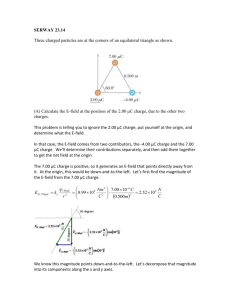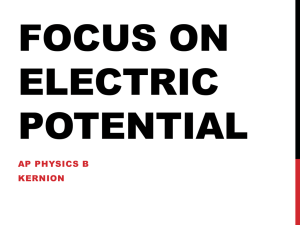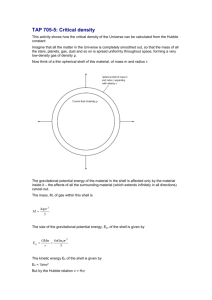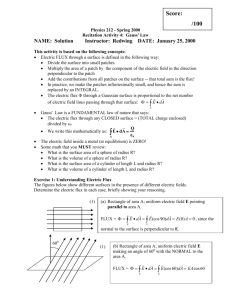ExIrev05ans
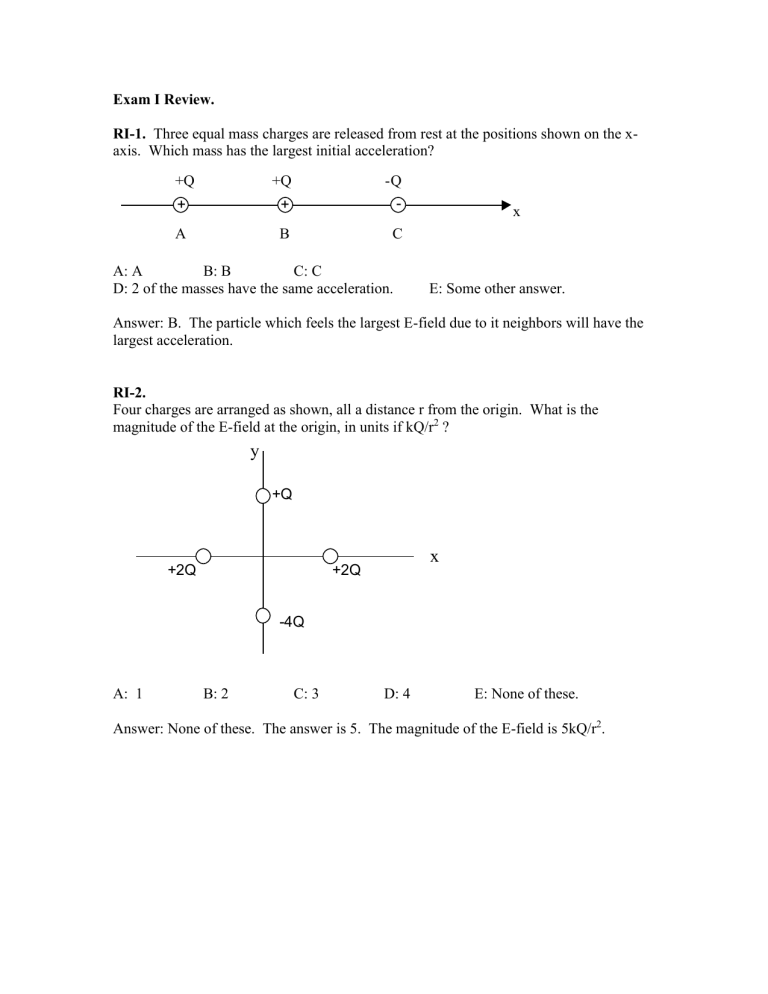
Exam I Review.
RI-1. Three equal mass charges are released from rest at the positions shown on the xaxis. Which mass has the largest initial acceleration?
+Q
+
+Q
+
-Q
- x
A B C
A: A B: B C: C
D: 2 of the masses have the same acceleration. E: Some other answer.
Answer: B. The particle which feels the largest E-field due to it neighbors will have the largest acceleration.
RI-2.
Four charges are arranged as shown, all a distance r from the origin. What is the magnitude of the E-field at the origin, in units if kQ/r
2
? y
+Q x
+2Q +2Q
-4Q
A: 1 B: 2 C: 3 D: 4 E: None of these.
Answer: None of these. The answer is 5. The magnitude of the E-field is 5kQ/r
2
.
RI-3. A line of charge has length L and total charge Q.
What is the relation between dx and dQ?
A: dx = (Q/L) dQ
D: None
B: dQ = (L/Q) dx dE point A
h
C: dQ = (Q/L) dx dx, dQ
0 x
L
At point A, what is the magnitude of the field dE due to the element of charge dQ?
A: k dQ h 2
x 2
B: k dQ h
2 x
2
What is the correct expression for sin
? x
A: h
2 x
2
B: h h
2 x
2 h
C: h
2 x
2
What is the correct expression for dE x
?
k h (Q / L)dx
A: h 2 x 2
3/ 2 B: h
2 x
2
C: k dQ h 2
x 2
D:
C: x h
2 x
2
h
2 x
2
3/ 2
Answers: dQ = (Q/L) dx dE x
dE sin
dE
k dQ h
2 x
h 2
x 2
3/ 2
2 sin
x h
2 x
2
RI-4. A point charge +Q is brought near a large metal plate and the field lines are as shown. Does the plate have a non-zero net charge?
A: Yes B: No
+
Is the magnitude of the charge on the plate greater, less, or the same as the charge Q?
A: greater B: less C: same.
Answers: Yes, the plate has a net negative charge, because field lines terminate on it, but no field lines begin on it.
The plate has a smaller magnitude negative charge than the point charge . There are 8 fields lines coming out of the point charge, but only 5 field lines entering the plate.
RI-5. If the electric field
over a surface be zero
E is non-zero everywhere on a closed surface S, can the flux
S z
0
?
A: Yes B: No
A: Yes B: No
Answers:
Yes. A simple example is a constant E-field
S z
E
€
0 for any closed surface in the field.
. The E-field is non-zero , yet
NO!!! In order to "pull the E outside the surface integral" you must first have that
E da everywhere on the surface so that E da
E da , and then you must have magnitude of the field = E = constant over the surface.
RI-6.
A long, straight line of charge has charge per length
. Does Gauss's law allow you to compute the flux
S
through the spherical surface of diameter D, centered on the line? A: Yes B: No
D
Consider now the open hemispherical surface (shaped like a cup) centered on the line as shown. Does Gauss's law allow you to compute the flux
S
through this surface?
(Taking the outward normal direction as positive.) A: Yes B: No
D/2
Answers:
Yes.
S
E da
Q enc
o
, and Q enc
=
D, so
S
E da
D
o
.
Yes. Apply Gauss's Law to the closed hemisphere. The surface integral over the flat portion is zero (since E-field perpendicular to surface there). So we can write
opencup
E da
E da
2
D o
.
RI-7.
The electric field throughout a region of space is given by the formula
E
€ €
, where (x,y) are the coordinates of a point in space, and A, B are constants. What is
€
?
A: Ay B: Bx C: Ax D: By E: None of these.
Answer:
Ay.
€
A y x x B x y x Ay . Since
€ €
1 .
RI-8.
An insulating spherical shell with a uniform positive charge density on its surface is near a positive point charge. Is the electric field inside the sphere zero?
+ +
A) E=0 inside
+ +
B) E
0 inside
+
+
E=?
+
+
+
+ C) Not enough info to answer.
+
+
+
Answer: E inside is NOT zero. E total
= E shell
+ E point
Inside, the shell, E shell
=0, but the field due to the point charge is still present. This is not a metal shell, so there is no polarization of the charge on the shell and no “screening”.
RI-9.
A spherical shell of charge has a non-uniform distribution of charge over its surface. Is the electric field everywhere within the shell zero?
A: Yes
E=0?
B: No
RI-9
Answer: No. The E-field inside a uniform, spherical shell of charge is zero. But if the charge is non-uniform, the E-field will not cancel inside the sphere.
RI-10. Consider a point charge +Q off-center within a spherical metal shell. Does Gauss's Law allow you to compute the total charge on the inside surface of the shell?
A: Yes B: No
Does the total charge on the inside surface of the shell depend on the total net charge of the whole shell?
A: Yes B: No
Consider a dipole within a spherical metal shell.
Is there a non-zero surface charge density
on the inside surface of the shell?
A: Yes B: No
+Q -Q
Answers: Yes, you can compute the total charge on the inside surface. Consider the flux
S
over a spherical surface within the metal.
+Q
Since the E-field must be zero everywhere within the conductor, then
S
Q enc
/ 0.
Since Q enc
= 0, there must be a charge -Q spread over the inside surface of the conductor. Since the point charge +Q is off-center, the surface -Q will not be spread uniformly over the inside surface.
No, the total charge on the inside surface does not depend on the net charge of the shell.
It only depends on the value of the charge within the cavity inside the shell.
Yes, there must be a (non-zero, non-uniform) charge density on the inner surface. Since the E-field within the conductor must be zero, there must be some charges on the surfaces of the conductor which create an E-field which cancels the E-field due to the dipole.
RI-11.
Consider two very large, parallel metal plates in static equilibrium. Consider also the gaussian surface shown. It is proposed that the charge densities on the four surfaces are as shown. Is this possible?
A: Yes B: No
+4
-2
+
+
Answer: No. This is not possible. Since E=0 within a conductor, the flux over the imaginary surface shown must be zero
S
E da
0 . Therefore, by Gauss's Law, the enclosed charge must be zero. But if the enclosed charge is zero, the charge densities on
"facing faces" must be equal and opposite.

